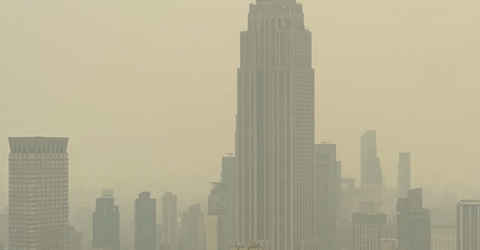As of Monday, August 4, New York has entered an air quality advisory due to 744 active wildfires raging in Canada.
The Department of Environmental Conservation (DEC) and the State Department of Health (DOH) have issued air quality health advisories for much of New York State, but Long Island and the New York City metro regions are now also facing concerns of ozone.
According to the DEC, Ozone is a harmful air pollutant that forms when sunlight reacts with certain chemicals, such as automobile exhaust and industrial emissions. It is particularly enhanced by the presence of wildfire smoke, in this case from the Canadian wild fires.
“Individuals experiencing symptoms such as shortness of breath, chest pain, or coughing should consider consulting their personal physician,” said the DEC in the advisory.
Fine particulate matter is the second pollutant of concern, and is the one that’s affecting New York State at large.
Also according to the DEC, fine particulate matter is made up of a range of particles, often coming from combustion. Think vehicle exhaust, power plants and, yes, wild fires.
“Exposure can cause short-term health effects, such as irritation to the eyes, nose, and throat, coughing, sneezing, runny nose, and shortness of breath. Exposure to elevated levels of fine particulate matter can also worsen medical conditions such as asthma and heart disease,” as stated in the advisory.
The Air Quality Index (AQI) is expected to reach a value higher than 100, signifying unhealthy air and respiratory health concerns for at-risk individuals. New Yorkers should expect hazy skies and stay inside when possible.
The alert went into effect in the early hours of Monday morning, and it expected to remain until at least 12 a.m. on Tuesday, August 5.
